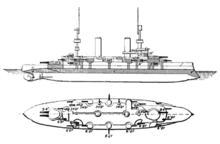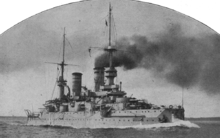SMS Kaiser Karl der Grosse
 Kaiser Karl der Grosse in 1902
| |
| History | |
|---|---|
| Name | Kaiser Karl der Grosse |
| Namesake | Charlemagne (Karl der Grosse in German) |
| Builder | Blohm & Voss, Hamburg |
| Laid down | 17 September 1898 |
| Launched | 18 October 1899 |
| Commissioned | 4 February 1902 |
| Decommissioned | 19 November 1915 |
| Stricken | 6 December 1919 |
| Fate | Scrapped in 1920 |
| General characteristics | |
| Class and type | Kaiser Friedrich III-class pre-dreadnought battleship |
| Displacement |
|
| Length | 125.3 m (411 ft 1 in) |
| Beam | 20.4 m (66 ft 11 in) |
| Draft | 7.89 m (25 ft 11 in) |
| Installed power |
|
| Propulsion |
|
| Speed | 17.5 knots (32.4 km/h; 20.1 mph) |
| Range | 3,420 nmi (6,330 km; 3,940 mi) at 10 knots (19 km/h; 12 mph) |
| Complement |
|
| Armament |
|
| Armor |
|
SMS Kaiser Karl der Grosse
Kaiser Karl der Grosse served with the active fleet until 1908, participating in the normal peacetime routine of training cruises and fleet maneuvers. By 1908, the new "all-big-gun"
Design

After the German
Kaiser Karl der Grosse was 125.3 m (411 ft 1 in)
The ship's armament consisted of a
Service history
Construction through 1904

German Emperor (Kaiser)
Kaiser Karl der Grosse was assigned to II Division of I Squadron on 19 February, the last member of her class to enter active service. With the assignment of Kaiser Karl der Grosse, I Squadron was now fully composed of modern battleships. The squadron went on a training cruise to Britain in April and May, followed by a tour of the

In 1903, the fleet, which was composed of only one squadron of battleships (along with its attendant scouting vessels and torpedo boats), was reorganized as the "Active Battle Fleet." Kaiser Karl der Grosse remained in I Squadron along with her sister ships and the newest Wittelsbach-class battleships, while the older Brandenburg-class ships were placed in reserve in order to be rebuilt.[10] The first quarter of 1903 followed the usual pattern of training exercises. The squadron went on a training cruise in the Baltic, followed by a voyage to Spain that lasted from 7 May to 10 June. In July, she joined I Squadron for the annual cruise to Norway. The autumn maneuvers consisted of a blockade exercise in the North Sea, a cruise of the entire fleet first to Norwegian waters and then to Kiel in early September, and finally a mock attack on Kiel. The exercises concluded on 12 September. The winter training cruise began on 23 November in the eastern Baltic and continued into the Skagerrak in early December.[11]
Kaiser Karl der Grosse participated in exercises in the Skagerrak from 11 to 21 January 1904, with her squadron from 8 to 17 March, and with the fleet in the North Sea in May. In July, I Squadron and
1905–1914

In January and February 1905, Kaiser Karl der Grosse served briefly as the flagship of the squadron.[5] During this period, she took part in a pair of training cruises with I Squadron during 9–19 January and 27 February – 16 March 1905. Individual and squadron training followed, with an emphasis on gunnery drills. On 12 July, the fleet began a major training exercise in the North Sea.[15] While on the cruise on 18 July, Kaiser Karl der Grosse was detached to visit Antwerp to represent Germany during the celebrations for the 75th anniversary of the Belgian Revolution.[5] The rest of the fleet then cruised through the Kattegat and stopped in Copenhagen and Stockholm; Kaiser Karl der Grosse rejoined them on 3 August in Karlskrona. The summer cruise ended on 9 August, though the autumn maneuvers that would normally have begun shortly thereafter were delayed by a visit from the British Channel Fleet that month.[15]
The British fleet stopped in Danzig,
The fleet undertook a heavier training schedule in 1906 than in previous years. The ships were occupied with individual, division and squadron exercises throughout April. Starting on 13 May, major fleet exercises took place in the North Sea and lasted until 8 June with a cruise around the Skagen into the Baltic.[18] The fleet began its usual summer cruise to Norway in mid-July. Kaiser Karl der Grosse and I Squadron anchored in Molde, where they were joined on 21 July by Wilhelm II aboard the steamer Hamburg. The fleet was present for the birthday of Norwegian king Haakon VII on 3 August. The German ships departed the following day for Helgoland to join exercises being conducted there, arriving back in Kiel by 15 August, where preparations for the autumn maneuvers began. On 22–24 August, the fleet took part in landing exercises in Eckernförde Bay outside Kiel. The maneuvers were paused from 31 August to 3 September when Kiel hosted vessels from Denmark and Sweden, along with a Russian squadron from 3 to 9 September.[19] The maneuvers resumed on 8 September and lasted five more days. The ship participated in the uneventful winter cruise into the Kattegat and Skagerrak from 8 to 16 December.[20]
The first quarter of 1907 followed the previous pattern and, on 16 February, the Active Battlefleet was re-designated the
World War I

As a result of the outbreak of World War I, Kaiser Karl der Grosse and her sisters were brought out of reserve and mobilized as V Battle Squadron on 5 August 1914. The ships were prepared for war very slowly, and they were not ready for service in the North Sea until the end of August.
Prince Heinrich ordered a foray toward
Footnotes
Notes
- Seiner Majestät Schiff" (German: His Majesty's Ship).
- eszett, as Kaiser Karl der Große. Most English-language sources replace the eszett.
- ^ In Imperial German Navy gun nomenclature, "SK" (Schnelladekanone) denotes that the gun is quick firing, while the L/40 denotes the length of the gun. In this case, the L/40 gun is 40 caliber, meaning that the gun is 40 times as long as it is in diameter.[3]
Citations
- ^ Sondhaus, pp. 180–189, 216–218, 221–224.
- ^ a b c d Gröner, p. 15.
- ^ Grießmer, p. 177.
- ^ Herwig, pp. 24–26.
- ^ a b c d e f g h Hildebrand, Röhr, & Steinmetz, p. 39.
- ^ Hurd & Castle, p. 366.
- ^ Hildebrand, Röhr, & Steinmetz, pp. 39, 47.
- ^ Hildebrand, Röhr, & Steinmetz, pp. 39, 48.
- ^ Herwig, p. 45.
- ^ Hildebrand, Röhr, & Steinmetz, pp. 48–49.
- ^ Hildebrand, Röhr, & Steinmetz, pp. 51–52.
- ^ Hildebrand, Röhr, & Steinmetz, p. 52.
- ^ Hildebrand, Röhr, & Steinmetz, p. 54.
- ^ a b c Hildebrand, Röhr, & Steinmetz, pp. 54–55.
- ^ Campbell & Sieche, p. 134.
- ^ Hildebrand, Röhr, & Steinmetz, p. 55.
- ^ a b Hildebrand, Röhr, & Steinmetz, p. 58.
- ^ Hildebrand, Röhr, & Steinmetz, p. 59.
- ^ Hildebrand, Röhr, & Steinmetz, p. 60.
- ^ Hildebrand, Röhr, & Steinmetz, pp. 60–61.
- ^ a b Hildebrand, Röhr, & Steinmetz, p. 62.
- ^ a b Campbell & Sieche, p. 141.
- ^ European War Notes: Organization of the German Fleet, p. 1564.
- ^ Hildebrand, Röhr, & Steinmetz, pp. 62–63.
- ^ a b c Hildebrand, Röhr, & Steinmetz, p. 63.
- ^ a b Gröner, p. 16.
- ^ Treaty of Versailles Section II, Article 181.
References
- Campbell, N. J. M. & Sieche, Erwin (1986). "Germany". In Gardiner, Robert & Gray, Randal (eds.). Conway's All the World's Fighting Ships 1906–1921. London: Conway Maritime Press. pp. 134–189. ISBN 978-0-85177-245-5.
- "European War Notes: "Organization of the German Fleet"". Proceedings. 40. Annapolis: United States Naval Institute: 1564–1565. 1914.
- "German Naval Manoeuvres". R.U.S.I. Journal. 47. London: Royal United Services Institute for Defence Studies: 90–97. 1903. ISSN 0035-9289.
- Grießmer, Axel (1999). Die Linienschiffe der Kaiserlichen Marine: 1906–1918; Konstruktionen zwischen Rüstungskonkurrenz und Flottengesetz [The Battleships of the Imperial Navy: 1906–1918; Constructions between Arms Competition and Fleet Laws] (in German). Bonn: Bernard & Graefe Verlag. ISBN 978-3-7637-5985-9.
- ISBN 978-0-87021-790-6.
- Herwig, Holger (1998) [1980]. "Luxury" Fleet: The Imperial German Navy 1888–1918. Amherst: Humanity Books. ISBN 978-1-57392-286-9.
- Hildebrand, Hans H.; Röhr, Albert & Steinmetz, Hans-Otto (1993). Die Deutschen Kriegsschiffe: Biographien – ein Spiegel der Marinegeschichte von 1815 bis zur Gegenwart [The German Warships: Biographies − A Reflection of Naval History from 1815 to the Present] (in German). Vol. 5. Ratingen: Mundus Verlag. ISBN 978-3-7822-0456-9.
- Hurd, Archibald; Castle, Henry (1913). German Sea Power: Its Rise, Progress, and Economic Basis. New York: Charles Scribner's Sons. OCLC 607759576.
- Sondhaus, Lawrence (1997). Preparing for Weltpolitik: German Sea Power Before the Tirpitz Era. Annapolis: Naval Institute Press. ISBN 978-1-55750-745-7.
Further reading
- Koop, Gerhard & Schmolke, Klaus-Peter (2001). Die Panzer- und Linienschiffe der Brandenburg-, Kaiser Friedrich III-, Wittlesbach-, Braunschweig- und Deutschland-Klasse [The Armored and Battleships of the Brandenburg, Kaiser Friedrich III, Wittelsbach, Braunschweig, and Deutschland Classes] (in German). Bonn: Bernard & Graefe Verlag. ISBN 978-3-7637-6211-8.
